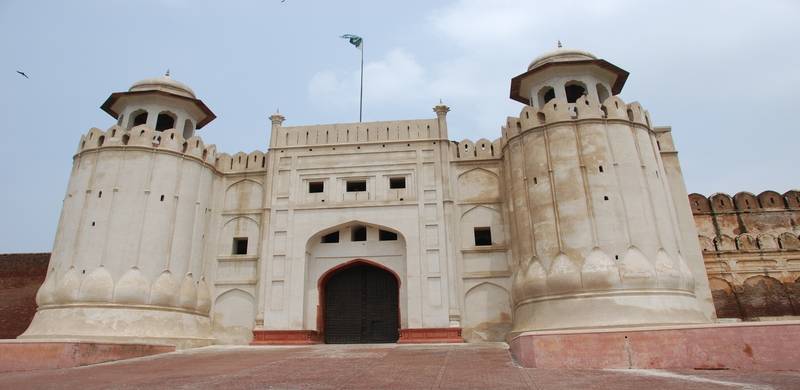
Part one of the 'Majestic Fort of Lahore' went over a brief history of the Lahore Fort. This piece would delve into the wonders associated with its unique gates. Despite visiting Lahore Fort several times, many people do not understand the charisma and impact of the imposing gates of Lahore Fort and even miss some of the gates. Readers of this piece would surely want to visit the Lahore Fort again and have another deeper look at the grand complex.
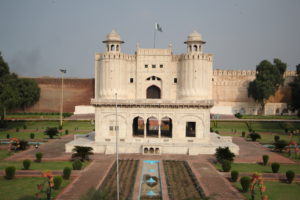
Let us begin from the Akbari or Masjidi Gate of the Lahore Fort, which was the original entrance to the fort during Mughal emperor Akbar’s rule. Just visualize the grandeur of Akbar’s entourage passing through the Delhi Gate, crossing the Royal Trail with people leaning over the balconies and jharokas to take a glimpse of their emperor and queen seated on decorated elephants, showering flowers over them. Then, following the royal trail, Akbar the Great enters into his splendid fort through the gigantic Akbari Gate! What a thrilling scene it would have been of the vibrant, enthralling entourage entering through this gate with guards standing at the sides with their heads bowed down for the emperor and the queen.
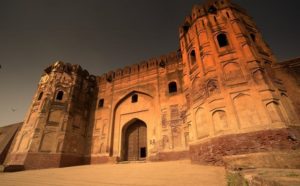
This magnificent gate, known as the Akbari Gate, was named after the third Mughal Emperor- Akbar the Great. Akbar rebuilt this fort with burnt bricks and added several mind-blowing structures to it. This gate, built in 1666, is located on the eastern side of the Lahore Fort and faces the Rim Market and Mariam Zamani Masjid which was built by Emperor Jahangir for his mother. Historians say that there was a garden which connected this gate with the mosque. The British demolished the garden and made a road there which is still used to reach Mariam Zamani Mosque. With the construction of this road, the fort was separated from the mosque.
This gate was once the main entrance to the Lahore Fort and till now, the stateliness of the gate can be seen in its ages-old bricks and huge structure. The gate is elevated from the ground level and wide enough for an elephant to cross through its wooden door.
The gate has two storeys with chambers inside it which must have been used by the watch guards and soldiers. The gate has a basement and it was known as Akbari Sarai (Akbar’s Rest House).
Till a few years ago, the gate was lying in shambles and there were wild plantations growing all around the place. One could see debris and waste piled up in front of the gate. in 2014, when the Lahore fort was handed over to the Walled City of Lahore Authority, the first thing done by the authority was cleaning of the waste and wild growth which was damaging the structure of the massive gate.
Another gate, which is relatively unknown, and which I found in ruins inside the fort for years, is the Masuman Gate, the conservation of which occurred in 2018-2019.
According to historic references, Musaman Gate was also known as Musaman Burj or Samman Burj, which means a ‘Jasmine Tower’. This gate is at a height if compared to the other gates of Lahore Fort and according to historic records, it was built by the Mughal Emperor Shah Jahan somewhere around 1632. This gate was also was used by royals for entering the fort.
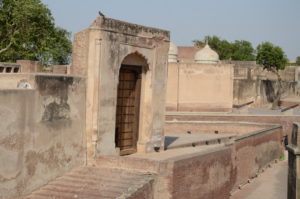
Nothing good happened to this gate with the passage of time. It was abandoned and remained in a poor condition. The stairs leading to it crumbled and few of the steps vanished. Around the gate, piles of debris could be seen and most of its parts were lost under the huge growth of wild plants.
According to old maps and historical references to Lahore Fort, the Alamgiri Gate, Royal Kitchen and Musaman Gate were connected with the Shah Burj through a garden. The royals would enter through this gate and by crossing the garden, they were able to reach the other parts of the fort like Deewan-e-Aam, Jahangir Quadrangle, Shah Jahan Khawabgah and most importantly, the Sheesh Mahal.
When the British took over the fort, they built a huge ramp-like road and separated the abovementioned places; what we see now is the British Era fort. While separating these places with a road, a Barood Khana, the arsenal depot, was also built by the British which is next to Musaman Gate. If you go to the British Bridge, it will take you to the Barood Khana straight away and on your left would be the Musaman Gate.
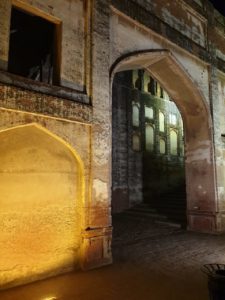
The Walled City of Lahore Authority started its conservation with archaeological excavations. The authority engaged in documentation through laser scanners and other technical equipment. One can imagine how ignored this piece of history was from the fact that almost 150,000 cubic feet of debris and wild plants were removed from this area. During the conservation, the concrete material which was used for the construction of this gate was also removed. The repairing of the plaster, floors, wooden doors, beams and ceilings was done and after the work was completed, the gate was illuminated.
Near the Musaman Gate is the Alamgiri Gate of Lahore Fort and the Temple of Prince Loh. This gate has also been conserved and has been illuminated for tourists.
The Shah Burj Gate is an amazing piece of architecture because of its decorative items. The gate has rooms inside it and these were conserved by the Walled City of Lahore Authority in 2019. The exterior of the gate is still under conservation. The rooms and chambers inside the gate are now functional and used as meeting rooms and crafts’ centres.
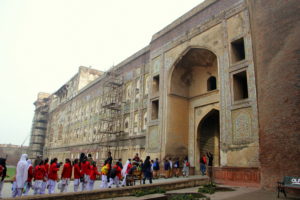
The magnificent Shah Burj Gate was built by Shah Jahan in 1631-32. The gate is now behind the British-era Postern Gate and provides access to Shish Mahal. The gate was originally reserved exclusively for the royal family and courtiers. This gate also leads to the elephant stairs and it is said that emperor Shah Jahan used these steps to go to the Sheesh Mahal.
The most renowned and largest structures of the Lahore Fort is the Alamgiri Gate. It was built by the Mughal emperor Aurangzeb Alamgir in 1673. It is the main entrance to the Lahore Fort from the west side, and faces the Badshahi Mosque and Huzoori Bagh.
The monumental gateway is an imposing vestibule flanked by two semi-circular bastions that have boldly fluted shafts and lotus petal bases and are crowned with domed pavilions.
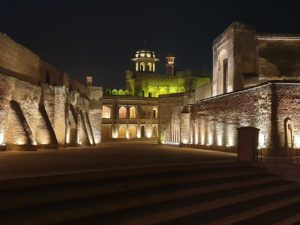
The huge arched entrance in the centre was designed to allow the emperor's elephant-mounted caravan to pass through. It leads to the central square hall which has deep arched recesses on the east and north and a staircase leading to the upper storey buildings. The archway on the south leads to the interior of the fort.
It is said that during a war between the Sikhs and the British, the gate was destroyed and later the British rebuilt this gate. What we see today is the British-built gate. This gate connects the grand Badshahi Mosque, also built by Aurangzeb, with the fort via Huzoori Bagh.
Till almost two decades ago, this gate was the main entrance to Lahore fort for the visitors. You will still see a ticket counter inside this gate. It was conserved by the Archaeology Department back in 2006 or 2007. With the passage of time and because of security reasons, this gate was closed for the public and now those who intend to enter the fort do so through the Postern Gate or the Shah Burj Gate.
This gate has also been illuminated by the Walled City of Lahore Authority and tourists can see its full glory at night.

Let us begin from the Akbari or Masjidi Gate of the Lahore Fort, which was the original entrance to the fort during Mughal emperor Akbar’s rule. Just visualize the grandeur of Akbar’s entourage passing through the Delhi Gate, crossing the Royal Trail with people leaning over the balconies and jharokas to take a glimpse of their emperor and queen seated on decorated elephants, showering flowers over them. Then, following the royal trail, Akbar the Great enters into his splendid fort through the gigantic Akbari Gate! What a thrilling scene it would have been of the vibrant, enthralling entourage entering through this gate with guards standing at the sides with their heads bowed down for the emperor and the queen.

This magnificent gate, known as the Akbari Gate, was named after the third Mughal Emperor- Akbar the Great. Akbar rebuilt this fort with burnt bricks and added several mind-blowing structures to it. This gate, built in 1666, is located on the eastern side of the Lahore Fort and faces the Rim Market and Mariam Zamani Masjid which was built by Emperor Jahangir for his mother. Historians say that there was a garden which connected this gate with the mosque. The British demolished the garden and made a road there which is still used to reach Mariam Zamani Mosque. With the construction of this road, the fort was separated from the mosque.
This gate was once the main entrance to the Lahore Fort and till now, the stateliness of the gate can be seen in its ages-old bricks and huge structure. The gate is elevated from the ground level and wide enough for an elephant to cross through its wooden door.
The gate has two storeys with chambers inside it which must have been used by the watch guards and soldiers. The gate has a basement and it was known as Akbari Sarai (Akbar’s Rest House).
Till a few years ago, the gate was lying in shambles and there were wild plantations growing all around the place. One could see debris and waste piled up in front of the gate. in 2014, when the Lahore fort was handed over to the Walled City of Lahore Authority, the first thing done by the authority was cleaning of the waste and wild growth which was damaging the structure of the massive gate.
Another gate, which is relatively unknown, and which I found in ruins inside the fort for years, is the Masuman Gate, the conservation of which occurred in 2018-2019.
According to historic references, Musaman Gate was also known as Musaman Burj or Samman Burj, which means a ‘Jasmine Tower’. This gate is at a height if compared to the other gates of Lahore Fort and according to historic records, it was built by the Mughal Emperor Shah Jahan somewhere around 1632. This gate was also was used by royals for entering the fort.

Nothing good happened to this gate with the passage of time. It was abandoned and remained in a poor condition. The stairs leading to it crumbled and few of the steps vanished. Around the gate, piles of debris could be seen and most of its parts were lost under the huge growth of wild plants.
According to old maps and historical references to Lahore Fort, the Alamgiri Gate, Royal Kitchen and Musaman Gate were connected with the Shah Burj through a garden. The royals would enter through this gate and by crossing the garden, they were able to reach the other parts of the fort like Deewan-e-Aam, Jahangir Quadrangle, Shah Jahan Khawabgah and most importantly, the Sheesh Mahal.
When the British took over the fort, they built a huge ramp-like road and separated the abovementioned places; what we see now is the British Era fort. While separating these places with a road, a Barood Khana, the arsenal depot, was also built by the British which is next to Musaman Gate. If you go to the British Bridge, it will take you to the Barood Khana straight away and on your left would be the Musaman Gate.

The Walled City of Lahore Authority started its conservation with archaeological excavations. The authority engaged in documentation through laser scanners and other technical equipment. One can imagine how ignored this piece of history was from the fact that almost 150,000 cubic feet of debris and wild plants were removed from this area. During the conservation, the concrete material which was used for the construction of this gate was also removed. The repairing of the plaster, floors, wooden doors, beams and ceilings was done and after the work was completed, the gate was illuminated.
Near the Musaman Gate is the Alamgiri Gate of Lahore Fort and the Temple of Prince Loh. This gate has also been conserved and has been illuminated for tourists.
The Shah Burj Gate is an amazing piece of architecture because of its decorative items. The gate has rooms inside it and these were conserved by the Walled City of Lahore Authority in 2019. The exterior of the gate is still under conservation. The rooms and chambers inside the gate are now functional and used as meeting rooms and crafts’ centres.

The magnificent Shah Burj Gate was built by Shah Jahan in 1631-32. The gate is now behind the British-era Postern Gate and provides access to Shish Mahal. The gate was originally reserved exclusively for the royal family and courtiers. This gate also leads to the elephant stairs and it is said that emperor Shah Jahan used these steps to go to the Sheesh Mahal.
The most renowned and largest structures of the Lahore Fort is the Alamgiri Gate. It was built by the Mughal emperor Aurangzeb Alamgir in 1673. It is the main entrance to the Lahore Fort from the west side, and faces the Badshahi Mosque and Huzoori Bagh.
The monumental gateway is an imposing vestibule flanked by two semi-circular bastions that have boldly fluted shafts and lotus petal bases and are crowned with domed pavilions.

The huge arched entrance in the centre was designed to allow the emperor's elephant-mounted caravan to pass through. It leads to the central square hall which has deep arched recesses on the east and north and a staircase leading to the upper storey buildings. The archway on the south leads to the interior of the fort.
It is said that during a war between the Sikhs and the British, the gate was destroyed and later the British rebuilt this gate. What we see today is the British-built gate. This gate connects the grand Badshahi Mosque, also built by Aurangzeb, with the fort via Huzoori Bagh.
Till almost two decades ago, this gate was the main entrance to Lahore fort for the visitors. You will still see a ticket counter inside this gate. It was conserved by the Archaeology Department back in 2006 or 2007. With the passage of time and because of security reasons, this gate was closed for the public and now those who intend to enter the fort do so through the Postern Gate or the Shah Burj Gate.
This gate has also been illuminated by the Walled City of Lahore Authority and tourists can see its full glory at night.
